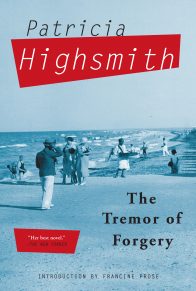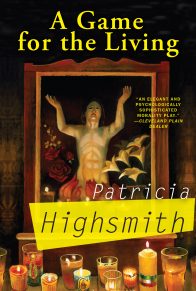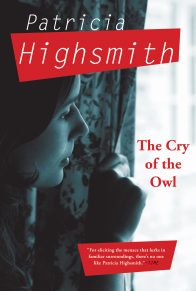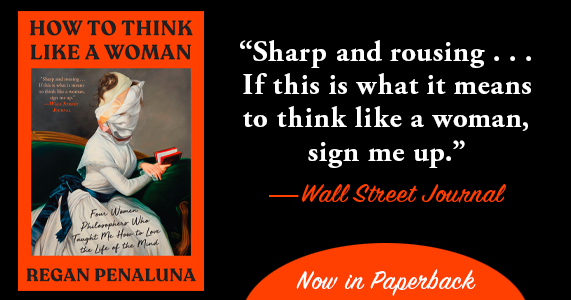On the outskirts of the small town of G— in eastern Austria lies a mysterious cemetery hardly an acre in size, filled with the remains of paupers for the most part, their places marked by nothing at all, or at best by tombstone fragments now all in the wrong spots. Yet the cemetery became famous for its odd excrescences, bulbous figurines of bluish-green and off-white color, which eerily rose above the surface of the soil and grew, some, to a height of two meters or so. Others of these mushroom-like growths attained only fifty centimeters, some were even smaller, and all were bizarre, like nothing else in nature, even coral. When several such small ones had manifested themselves above the grassy and muddy earth, the cemetery caretaker called it to the attention of one of the nurses in the adjacent National Hospital. The cemetery lay to the rear of the red-brick hospital building, so one did not easily see the cemetery when approaching the hospital on the one road that went past it with a turn-off toward the hospital’s front doors.
The caretaker, Andreas Silzer, explained that he had knocked down a couple of these growths with his hoe, taken them to the compost heap expecting them to rot, but they hadn’t.
“Just a fungus, but there’s more coming,” said Andreas. “I’ve put fungicide down, but I don’t want to kill off the flowers with anything stronger.” Andreas faithfully cared for pansies, rosebushes and the like which a few relatives of the deceased had planted. Occasionally he was tipped for his services.
The nurse did not answer for several seconds. “I’ll speak to Dr Muller. Thank you, Andreas.”
Nurse Susanne Richter did not report what Andreas had said. She had her reasons, or rationalizations. The first was that Andreas was probably exaggerating, and that he had seen a few big mushrooms on the tombstones because of all the rain lately; secondly, she knew her place, which wasn’t a bad one and she wanted to keep it and not become known as a busybody meddling on territory not assigned to her, namely the cemetery.
Almost no one set foot in the dark field behind the National Hospital except Andreas, who was about sixty-five and lived with his wife in town. He bicycled to work three days a week. Andreas was semi-retired, and received a stipend for his cemetery and hospital ground-tending in addition to his state pension. The approximately three-a-month funerals were usually attended by the local priest who said a few words, by the gravediggers who stood by to do the filling in, and only about half the time by a member of the deceased’s family. Some of the elderly men and women who died were quite alone in the world, or their children lived far away. It was a sad place, the National Hospital Number Thirty-six.
It was not sad, however, to a young medical student of the University of G— named Oktavian Ziegler. He was twenty-two, tall and thin, but possessed of an energy and sense of humor that made him popular with girls. He was also a brilliant student, and rather favored by his teachers. Oktavian—he was so called because his father, an oboist, worshipped the music of Richard Strauss and had hoped his son might become a composer—had been invited, in fact, to be present at some experiments that doctors of the hospital and a couple of his doctor teachers were making on terminal cancer patients at the National Hospital. These experiments took place in a large room on the top storey of the hospital, where there were long tables, several sinks and good lighting. Sanitary conditions were not of the essence, as on this floor the experiments were done on corpses, or else upon bits of cancerous tissue excised from a living patient or from a corpse before it was buried in the cemetery. The doctors were trying to learn more about causes and cures and the reasons for the growth of cancer once it got started. In that same year, scientists in America had discovered that a particular quirk in one gene was a stepping stone toward cancer, but the dread disease needed a second stepping stone to start the malignant cells forming. Carcinogenic agents was the blanket term for the elements which when introduced into guinea pigs or any organism might initiate cancer if the host organism had by nature the first stepping stone. So much was now common knowledge. The doctors and scientists at the National Hospital wanted to learn more, the rate and the reasons for growth, the response of the cancer when massive doses of carcinogens were injected into already cancerous tissue, experiments that could not easily be performed upon living humans, but could upon an organ or a lump of tissue being nourished independently by a blood supply from a small pump, for instance. There was no way of purifying an amount of blood save by recycling the blood through cleansers or by constant supplies of fresh blood, but none of the doctors wanted to carry on an experiment for weeks on end. What the doctors and Oktavian did observe in regard to a cancerous liver section (from a dead patient) was that the diseased tissue, having been given carcinogenic agents, continued to grow even after the blood supply was halted and drained off. The doctors did not think it of any purpose to try to find out how large it would become, though they kept some of it to look at under their microscopes in case it could yield any new information. The disposal of these finally unwanted remnants took place in the cellar of the hospital where there was a good-sized furnace, separate from the heating system and used exclusively for the burning of bandages and soiled material of all kinds.
This was not so with the approximately three-a-month corpses which were buried without embalming and sometimes in a shroud instead of a wooden coffin in the cemetery. In some cancerous patients in their last days, when morphine had dulled their senses and local anaesthesia could do the rest, doctors injected carcinogenic agents, hoping for an explosive breakthrough, as journalists might say, though the doctors never would have used such a term. The cancers did enlarge, the patients being terminal did die, and not always any sooner because of these tests. Sometimes the enlarged growths were excised, mostly not.
Oktavian was given the chore, considered a menial one suitable for a student, of seeing that the “test corpses” got down by the big old back elevator from the top storey lab to the cemetery, after a brief tales of natural and unnatural catastrophes stop in the basement morgue for coffin or shroud. The gravediggers were part-time workers with other jobs. Oktavian had to telephone the two or three of them, sometimes on short notice, and they all did the best they could. One of the men was usually a little drunk, but Oktavian stuck with it, joked with the men, and made sure the grave was deep enough. Sometimes they had to inter a corpse on top of or right beside another. Lime was sometimes put down. This of course was for the poorer dead, who had no relatives attending. It was on one of these inhumations in autumn that Oktavian noticed the rounded excrescences that Andreas had reported to the nurse just days before. Oktavian noticed them as he puffed a rare cigarette and stomped his feet against the cold. He knew at once what they were and what had caused them, and he said not a word to the shoveling workmen near him. He did investigate one (he saw at least ten) near him, tripping over a fallen tombstone as he went, as it was rather a dark night. The thing looked bluish-white, was about fifteen centimeters high, rounded at the top with what looked like a convolution or crease halfway down it that disappeared in the earth. Oktavian was surprised, amused, anxious all at once. By comparison with what he and his seniors had produced in the lab, these growths were huge. And how big were they underneath the soil to have poked their way nearly two meters to the surface?
Oktavian returned to the gravediggers, and realized that he had been holding his breath. He supposed, he was almost sure, that the growths out there in the darkness were highly contaminous. They would combine the carcinogens injected by the doctors as well as the original berserk cells that had caused the cancer. How large would they become? And what was nourishing them? Terrifying questions! Oktavian, like most medical students, sent chums an odd part of the human anatomy once in a while. It was almost a token of affection when a fellow received such a present in the post from a girl student, but something like this? No.
“Let’s tread it down!” Oktavian said to the laborers, setting an example by starting to stomp on the rise of earth that marked the new grave. Stomp, stomp, stomp, all four of them together. And how long would it be before a pale curve pushed through the soil, Oktavian wondered?
The young man saved his secret until the following Saturday night when he had a date with Marianne, the girl he had considered for about a month now his favorite girl.
Marianne wasn’t very pretty, she studied like a demon, seldom took the time to put on lipstick and barely combed her light brown hair for their dates, but Oktavian adored her for her ability to laugh. After all her grinding away at her books, she could explode with joy and freedom after she closed the books, and Oktavian liked to think, though he was too realistic to believe it, that he was the sole agent of her transformation.
“Something special tonight,” Oktavian said when he picked her up in the downstairs hall of her dorm. He had asked her to wear galoshes, and she had. Oktavian had a two-seat motorcycle.
“You don’t mean we’re going hiking in the dark!”
“Wait!” Oktavian zoomed off.
It was raining slightly, there were gusts of cold wind. A wretched night, but it was Saturday night, Marianne clung to Oktavian’s waist, ducked her helmeted head and laughed as Oktavian sped into the countryside.
“Here!” he said finally, stopping.
“The hospital?”
“No, the cemetery,” he whispered, and took her hand. “Come with me.”
He held her hand all the way. The ghostly pale growths were higher, Oktavian thought, or was he imagining? Marianne was speechless with astonishment. She couldn’t laugh. She gasped, puzzled. Oktavian explained to her what the growths were. He had brought a torch. One bulbous thing was nearly a meter high! It looked rather like a foetus, Marianne remarked, at that stage when fish and mammal show their rudimentary gills under the head-to-be. Marianne was artistic; Oktavian might never have remarked that.
“What’re they going to do?” she whispered. “Don’t the doctors know about this?”
“I dunno,” Oktavian replied. “Somebody’ll report it.”
Oktavian had been trying to draw her toward the center of the dark field. Beyond and to their left, the five-storey hospital building loomed, with half its windows illuminated. The top floor was alight. “Just look at that!” cried Oktavian, his wandering torch having touched on something.
This was a double growth, rather like a pair of Siamese twins with joined hips, two separate heads, and with two arms that showed fingers—not five fingers on each hand, but something like a few fingers—at the ends of both arms. An accident, to be sure, but weird. Oktavian smiled crookedly, but could not laugh. Marianne tugged at him. “Okay,” he said. “I swear—I think I just saw one of ’em grow!”
Marianne led the way back to the motorcycle. It seemed amazing to Oktavian that no doctor or nurse had looked out and seen what was going on in that field. Comical to think of doctors, interns, nurses all so busy at their appointed tasks that they hadn’t a few seconds to look out of a window or take a short walk!
Half an hour later, when Marianne and Oktavian sat in a little inn eating hot and spicy goulash, while a cheerful fire crackled in a hearth not far from them, they did laugh, albeit in nervous spasms.
“. . . got to tell Hans!” Oktavian said. “He’ll flip out!”
“And Marie-Luise. And Jakob!” Marianne grinned like her Saturday evening self.
“Better have a party. Soon. Because the time is short.” Oktavian spoke earnestly across the table.
Marianne knew what he meant. They made plans, drew up a list of a select twelve or so. It should be next Tuesday night, they decided. Next Saturday might be too late, the hospital might have discovered the state of the cemetery and done something about it.
“A ghost party,” said Marianne. “We’ll come in sheets—even if it’s raining.”
Oktavian did not reply, as Marianne knew him well enough to know that he was in accord. He was thinking, could rainwater contribute to the growth of those insane tumors? Could the soil? After the supply of blood in the corpses had been exhausted, could the busy blood vessels that fed the cancers start capturing earth worms, maggots for their meager nutrients? Did the capillaries even reach out for adjacent corpses? Whatever the answers to those questions, the fact was plain that the death of the host did not mean the end of the cancer.
There were some smirks, some cynical disbelief, when Oktavian and Marianne extended discreet verbal invitations to the Real Ghost Party Tuesday Night at the Cemetery of the National Hospital Number Thirty-six. Wear a sheet or bring one and turn up at a quarter to midnight were the instructions.
Again it rained slightly on Tuesday evening, though there had been two or three days without rain, and Oktavian had hoped that the good weather would hold. However, the Schnörlregen did not dampen the spirits of the dozen or more medical students who arrived at the cemetery more or less punctually, some on bicycles, as they had been warned not to make any noise, because nobody wanted the hospital staff descending upon them.
There were muted “Ooohs!” and other exclamations when the sheeted students investigated the burial ground, though Oktavian had admonished everyone to keep silent. “It’s phoney!—Plastic balls! You so-and-so!” one girl whispered loudly to Oktavian.
“No!—No!” Oktavian whispered back.
“Wheest! My God, look at this!” cried a young man, trying to keep his voice low.
“Cancer patients? Holy Mother of God, Okky, what kind of experiments are going on here?” said an earnest fellow near Oktavian.
Sheeted figures circled the cemetery, drifted among the tombstones in the moonless night, shining pocket torches carefully downward to avoid tripping and detection. Oktavian had imagined calling for a circular ballet-of-ghosts round the cemetery, but was afraid to use his voice for this, and there was no need. Out of nervous excitement, fear, collective puzzlement, the students began a dance not at first in the same direction, but a dance which soon organized itself into a counter-clockwise ring which stumbled, recovered, held hands, hummed, giggled softly, and wafted its pale and sodden sheets in the wind.
The lights of the National Hospital glowed as ever, nearly half the windows bright rectangles of light, Oktavian noticed. He was holding Marianne’s hand and that of another fellow.
“Look at this! Hey, look!” said a boy’s voice. The boy was focusing his torch on something as high as his hip. “Pink below! I swear!”
“Shut your trap, for Chris’ sake!” Oktavian whispered back.
At that moment, Oktavian saw a young man on the other side of the ring kick at a pale lump, and heard him laugh. “They’re fixed in the ground! They’re rubber!”
Oktavian could have killed the fellow! He didn’t deserve to get his medical degree! “It’s real, you fool,” Oktavian said. “And shut up!”
“Measles, magpies, maggots, mumps!” the students chanted, swinging their legs as in a conga line. The circle slowly rotated.
A whistle blew.
“Okay, run!” Oktavian shouted, realizing that a hospital guard had seen or heard them, maybe the old guy who was half the time asleep at midnight just inside the front doors. Oktavian ran with Marianne toward his motorcycle at the edge of the road.
The others followed, laughing, falling, crying out. Some had cars, but the cars were a little distance away.
“Hey!” Oktavian said to a boy and girl near him. “Keep this quiet! Pass the word!”
They dispersed in surprisingly good silence, sheets folded, like a trained army. Oktavian rolled his motorcycle several meters before starting the motor. Behind them, slowly moving figures with torches, people from the hospital, were investigating the edges of the cemetery.
Oktavian lay low in the next days. He had plenty of work to do at the university, and so had the others. But they looked at the G— Anzeiger, the town newspaper. There was not even the tiniest item about a “disturbance” or “vandals” in the National Hospital’s cemetery, and this silence Oktavian had foreseen: the authorities could not afford to report that anyone had trampled on the graves or upset a couple of flower pots, because then they would have some of the relatives of the deceased coming to rectify the damage and to complain about lack of care, and the hospital would not want the public to learn about the odd growths, numerous enough now to catch anyone’s eye. The hospital people must be thoroughly alarmed, Oktavian thought.
On Thursday evening, Oktavian went to the National Hospital at 9 as usual to join the doctors on the top floor. He had glanced at the cemetery when he parked his motorcycle. The cemetery had been as dark as ever, but he had still seen pale balloon shapes in it, six or seven, maybe the same as before. Upstairs, the atmosphere was different. Dr Stefan Roeg, the youngest of the doctors and the one Oktavian had always got along best with, said hello and then good night in almost the same sentence. He had his overshoes and umbrella in his hands, though it wasn’t raining, and plainly he had turned up just to collect them. Old Professor Braun, whose head was in the clouds and whose head was bald except for the long wisps of grey hair above his ears, was the only person among the seven of them who acted the same as ever. He was ready to talk about the “progress” of little bits of tissue under glass bells since last week. Oktavian could see that the others had given it up. Their faces wore polite smiles as they bade Professor Braun good night.
“It is dangerous,” one doctor said hastily to Professor Braun before he departed.
Oktavian also managed to sneak out. Would old Professor Braun keep on working till after midnight, all alone? Oktavian and the doctors were silent as they tramped down the five flights of stairs. Oktavian thought it wise to ask no questions. They all knew an awful secret. The doctors were treating him, a mere student, as one of them. Had the doctors a plan of action? Or were they simply going to keep quiet?
Word somehow leaked out. A few curious townspeople went to peer from a distance at the cemetery, Oktavian noticed when he paid a quick visit on his motorcycle. The three or four people were not venturing into the cemetery, just standing and staring from its edges at the growths which resembled tied-down balloons in the dusk. It was ghosts; evil spirits from the criminals and the horribly ill who had been buried there; it was an outlandish result of fall-out from atomic bomb testing; it was because of insanitary conditions at the National Hospital, which everyone knew was not the most modern of the nation. Marianne reported some of these explanations to Oktavian, having heard them from her dormitory housekeepers who hadn’t even seen the cemetery.
The death of Andreas Silzer was announced in the G— Anzeiger in a small paragraph. “Faithful caretaker of the National Hospital grounds.” He had died of “metastatic tumors.” Poor old Andreas would have been exposed for months to the growths in the cemetery, Oktavian thought. Were the authorities ever going to clean the place up?
Oktavian and Marianne rode up to the National Hospital one Saturday evening, and saw two large trucks in the parking area of the hospital. A couple of lanterns on the cemetery ground gave some illumination, and they saw figures moving about. On closer inspection, they could see that the figures wore surgical masks, grey uniforms, and wielded picks and shovels with gloved hands.
“Garbagemen!” Marianne whispered. “Look! They’re sticking the things into big plastic sacks!”
Oktavian saw. “Then what do they do with the sacks?” he said almost to himself. “Come on. Let’s leave.”
Only two days later, a garbageman collapsed. His wife refused to let him be taken to the National Hospital, and said he had got sick from working in the cemetery. Her talking took the lid off, because her words were printed in the Anzeiger. At once the other ‘sanitation workers’ began complaining of nausea and weakness. The cemetery and a few meters beyond it were cordoned off by a heavy wire fence with danger-of-death signs attached at intervals. A wide gate in the fence permitted the entry of a bulldozer which tore up the ground. Disinfectants of all kinds were poured on to the soil by workmen wearing coveralls and masks. Patients and staff were evacuated from the National Hospital, and the building itself was washed and disinfected. The Anzeiger said that a strange fungus had attacked the cemetery, and that until the medical authorities learned more about it, it was deemed wise to close the grounds to the public.
But the growths kept coming, small low-lying curves at first, all over the cemetery’s churned surface, then came faster growth as if out of nowhere—one meter, two meters in a fortnight. Artists came to sketch, sitting on campstools. Other people took snapshots, and the more wary stood at a distance and looked through binoculars. There was talk of massive removal of the cemetery’s soil to a depth of two or even three meters. But where would the authorities dump it? The Preservation-of-the-Sea people had weeks ago pushed through legislation: the cemetery soil from National Hospital Thirty-six of G— was not to be dumped into ocean or sea. Farmers and ecologists of the country protested against the burial of the cemetery on their land or on public land at whatever depth. Border guards of adjacent countries were double-checking lorries going out of the country, lest they be concealing cemetery debris.
Incineration was therefore decided on. Danger money reached absurd heights for the men who worked with derricks, getting the soil into containers which were wheeled to the hospital’s back door, through which so many corpses had moved in the opposite direction. The big old heating furnace and the waste furnace of the hospital were back in service, the only things in the building that were. The ashes came out to a smaller bulk than the soil, black and dark grey, but were handled by the workmen with similar caution. Were these to be dropped into the sea? No, that was forbidden too. There was really nothing to do with the ashes but store them in heavy plastic sacks in the basement morgue and on the ground floor of the building for the nonce.
And still the growths came, as if hundreds of spores had been scattered by all the hacking and digging, but that was merely a poetic thought, Oktavian reflected, because tumors did not grow from spores. Still it was amazing how fertile that cemetery soil was! But he forgot the National Hospital while he took his final examinations. Marianne had another year to go. Then they were thinking of marrying.
Despite some noisy official disapproval, but cheers from the radical-left-in-the-arts, sculptors began to include in their exhibitions works inspired by the forms they had seen and sketched in the National Hospital Thirty-six cemetery. These sculptures were not unpleasing, being composed of many curves like buttocks or breasts, depending on how one chose to interpret them. Some won prizes. One nearly-abstract resembled a plump woman holding a beach ball; another of a seated figure was called “maternity.”
The cemetery ground, though lower, continued to throw up its strange fruit. Masked and gloved workers—old pensioners mainly—hacked at their bases with hoes, as they might have hacked at stubborn weeds in their gardens at home. The roots of some growths were so deep that the workmen were inspired to suggest that the ground be excavated and burnt again. The town authorities were sick of it. They had already spent millions of schillings. They would simply keep the whole area fenced off and try to forget it. The road there didn’t go anywhere except past the empty hospital and up into the mountains where it became a lane used mostly by hikers. The cemetery would be forgotten. The press had already fallen silent on the subject. It was known that doctors had been conducting experiments relating to cancer in the National Hospital, but the blame for the cemetery’s condition was spread over so many, that no doctor or hospital administrator was charged with responsibility.
The authorities were wrong in thinking that the cemetery would be forgotten. It became a tourist attraction, surpassing by far the popularity of the Geburtshaus in G— of a minor poet. Postcards of the cemetery sold fantastically well. Artists came from many lands, scientists too (though their tests on specimens taken from the cemetery yielded no further information on the causes and cures of cancer). Artists and art critics commented that nature’s designs, as manifested in the cemetery’s growths, surpassed those of crystals in ingenuity and were not to be despised aesthetically. Some philosophers and poets compared the grotesque shapes to a man-made wreckage of his own soul, to an insane tinkering with nature, such as that which had resulted in the accursed atomic bomb. Other philosophers countered: “Is cancer not natural to man?”
Oktavian remarked to Marianne that they were safe in asking such a question, because the answer could be yes and no, or yes or no to various people, and the talk about it could go on forever.















